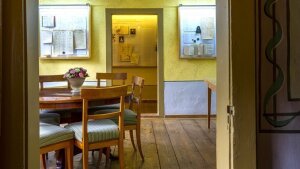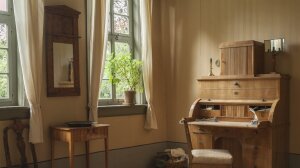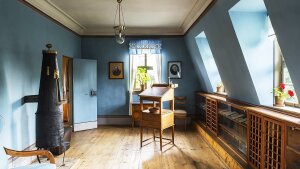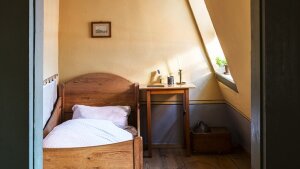After signing the purchase contract in March 1797, Schiller initiated extensive structural alterations to the garden house. In order to adapt the building to the needs of his household of seven, he had partition walls built on all floors and the upper part of the staircase relocated. A chimney and several ovens were also installed. Today, the house is largely as it was in Schiller's time - both in terms of the room layout and the paint and wallpaper finishes on the walls.
The exhibition space on ground floor
Image: Franco CogoliServant's room
In Schiller's time, the two female servants Christine and Wilhelmine Wetzel were housed in the first floor room directly next to the door to the garden. The sisters from Swabia, who came to Thuringia through Schiller's mother, did all the housework. They were also responsible for looking after the children. The two sons Karl (born 1793) and Ernst (born 1796) therefore also slept in the servants' quarters. Today, an exhibition in this room provides information about Schiller's decade in Jena and the history of the house.
Charlotte Schiller's living room
Image: Harald Wenzel-OrfCharlotte Schillers´s living quarters
Charlotte Schiller, née von Lengefeld, lived on the second floor. She had a parlor with an adjoining bedroom at her disposal. The parlor, which is decorated with “paille-yellow” wallpaper with a matching border, is furnished in the style of the period around 1800. The urn-shaped stove next to the door is one of the very few originals from Schiller's time that have survived in the garden house. It comes from the workshop of the Jena court coppersmith Christoph Gottlieb Pflug. The writing desk in the right-hand corner of the room is a replica of a piece of furniture that was originally made for Charlotte's mother, Louise von Lengefeld. The small tablets on the writing surface give an impression of Charlotte Schiller's readings. She wrote down sentences and verses from literary, historical and philosophical works on these small sheets of paper, which were kept in a separate box.
Charlotte Schiller is also depicted reading in the painting by Ludovike Simanowiz, a reproduction of which can be seen in the next room. A plaque to the left of the door recalls important stages in her biography and intellectual development. The documents in the chest of drawers by the window document Charlotte Schiller's interest in natural history and her part in the “Happy Event”, the friendship between Schiller and Goethe. The replica of a washstand, which Schiller's publisher Friedrich Cotta brought back from Leipzig during a visit in the spring of 1798 and gave to the lady of the house as a gift, is a reminder of the room's original purpose as a bedroom. If you would like to take a closer look at Charlotte Schiller in this place, please refer to the slipcase on the table in the living room. In addition to a biographical approach, it also contains letters from the garden house period, selected poems and excerpts from her diaries.
The mansard room
Image: Franco CogoliAttic
Im Dachgeschoß (Mansarde) verfügte Schiller über ein geräumiges Arbeitszimmer mit weitem Ausblick in verschiedene Himmelsrichtungen. In diesem Raum, der im Frühjahr 1798 mit blauer Tapete ausgestattet wurde, empfing er auch Besucher und las aus seinen Werken vor. Die Gartenhaus-Zeit gehört zu den literarisch produktivsten im Leben des Schriftstellers. Während der drei Sommer entstanden hier die berühmten Balladen für den »Musen-Almanach«, wesentliche Teile des »Wallenstein« und der »Maria Stuart« sowie das »Lied von der Glocke«. Unter den Fenstern der Westseite befanden sich Regale zur Aufbewahrung von Büchern und Manuskripten. Heute enthält die Bibliothek Erstausgaben von Schillers Werken sowie Jahrgänge der »Allgemeinen Literatur-Zeitung«, deren Speditionsgebäude sich in unmittelbarer Nähe ‒ am Standort der heutigen Post ‒ befand. Goethe hat diesen Raum wegen des schönen Ausblicks, den die Fenster der Südseite ins Saaletal gewährten, besonders geschätzt. An der Wand gegenüber hängt ein Kupferstich mit seinem Bildnis, den der Schweizer Künstler Johann Heinrich Lips im Jahr 1791 fertigte.
Attic
Schiller had a spacious study in the attic with a wide view in various directions. In this room, which was decorated with blue wallpaper in the spring of 1798, he also received visitors and read from his works. The garden house period was one of the most productive in the writer's life in literary terms. The famous ballads for the »Musen-Almanach«, significant parts of »Wallenstein« and »Mary Stuart« as well as the »Lied von der Glocke« ("Song of the Bell") were written here during the three summers. Under the windows on the west side were shelves for storing books and manuscripts. Today, the library contains first editions of Schiller's works as well as volumes of the »Allgemeine Literatur-Zeitung«, whose forwarding building was located in the immediate vicinity - on the site of today's post office. Goethe particularly appreciated this room because of the beautiful view that the windows on the south side afforded of the Saale valley. On the wall opposite is a copperplate engraving of his portrait, made by the Swiss artist Johann Heinrich Lips in 1791.
Schiller's chamber under the roof
Image: Franco CogoliBedchambers
There are two small chambers behind the study. The front one presents itself as Schiller's bedchamber, where he often only got to rest late due to bouts of illness. Alluding to this, Goethe called him “the saint of all human children suffering from sleeplessness” in a letter dated September 1797.
The second small chamber is furnished as a bedroom for Schiller's servant Gottfried Rudolph, the son of a hunchback apothecary from Oberweißbach in the Thuringian Forest, who entered Schiller's service in 1797 at the age of 19. Rudolph enjoyed a position of trust due to his particular reliability and also did clerical work for Schiller. He cared for Schiller during his last illness and kept various mementos of him. The original quill, which can be seen in the exhibition on the first floor, also came from his estate.



